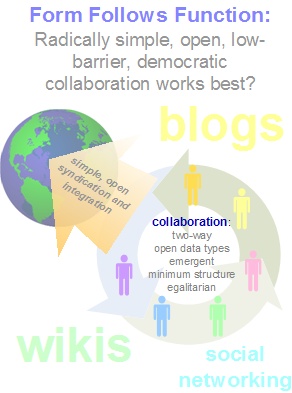Effective collaboration: Form follows function?

Harvard Business School's Andrew McAfee has been doing a compelling job lately describing the use of Web 2.0-style collaboration techniques in the enterprise. He calls this Enterprise 2.0 and has been reporting a very positive response to these concepts in the famed business school's most senior executive education program.
Specifically, McAfee defines Enterprise 2.0 as "the use of emergent social software platforms within companies, or between companies and their partners or customers." Things like blogs, wikis, and social networking tools are some examples of what could be Enterprise 2.0, depending on how they are used.

In one his most recent musings on the subject, McAfee makes a point that I believe will become one of the touchstones around the use of Web 2.0 in the enterprise:
Debate continues about whether Enterprise 2.0 is about new infrastructure or about new modes of collaboration. I've tried to be very clear that to me it's the latter, and not the former. Enterprise 2.0, in other words, is about new communities, not communities' new plumbing. If we keep talking about the plumbing we're going to lose the attention of business leaders. And that would be a shame.
The plumbing vs. communities debate is indeed an interesting and important one, particularly since I don't think one can be effectively separated from the other in this case. While I've described some of the key infrastructure concepts represented by Web 2.0 as a kind of Global SOA, this really only describes more ideal mechanisms by which people and information can be connected together on the Web. You can't have easier, more democratic, more free-form collaboration – along with the communities that form around this – without the right infrastructure that enables and encourages it.
Sidenote: If you're still on the bench on whether Web 2.0 in the enterprise is becoming a big deal, read BusinessWeek's new CEO's Guide to Web 2.0 which quotes IBM's Rod Smith claiming that their business customers are "ringing our phones off the hook" asking about it.Web-Oriented Architecture (discussion here and here), rich & open GUIs like Ajax, and syndication models like RSS are just some of the ways that newer, simpler, and increasingly ubiquitious Web infrastructure is enabling things like Web 2.0 and Enterprise 2.0. And while it's true that business leaders tend to prefer to focus on what first, and how second, understanding that form follows function is probably critical to actually exploiting this new way of using the Web and the intranet for true two-way collaboration.
In fact, this is the key lesson we seem to have learned from the rise of Web 2.0 in general; the Web was always able to work this way, and though it certainly did in some quarters, the methods and benefits are only now starting to become widespread knowledge.
Thus, accessing the benefits of Web 2.0 in the enterprise means understanding what it is and how to apply it. This can be a chicken and egg problem since there is no what without some how in this case. Blogs and wikis work so well because they are extremely simple ways to collaborate and hence more likely to be used by more people. This directly helps these collaboration models encounter fewer barriers to use and increased reuse and other second order usage scenarios. Appreciating what makes them simple and effective, which includes that they are delivered via a browser, require not prior training, little structure, and are syndicated via some mechanism is the essential function that provides the form we are looking for.
So, while there is surely a need to avoid the acronym soup that so often obscures the perceptions of any technique, this innovation cycle is already different from others in the past and is rightly focusing on aspect that matters most in all of this: people, and how they share information.
In this way, I believe that understanding how these technologies and techniques are specifically applied to human relationships is the key, not the cipher.